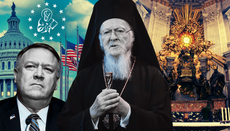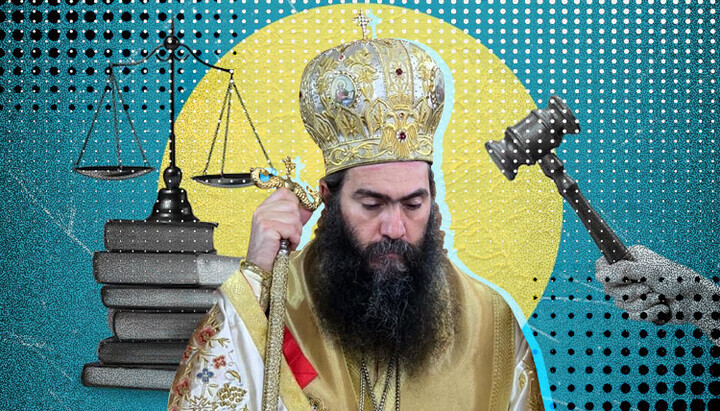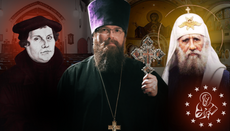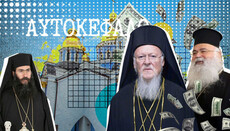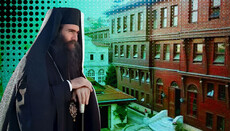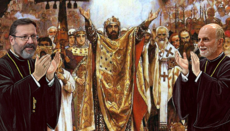Reformatting History by the UGCC: How Prince Vladimir Became a Uniate
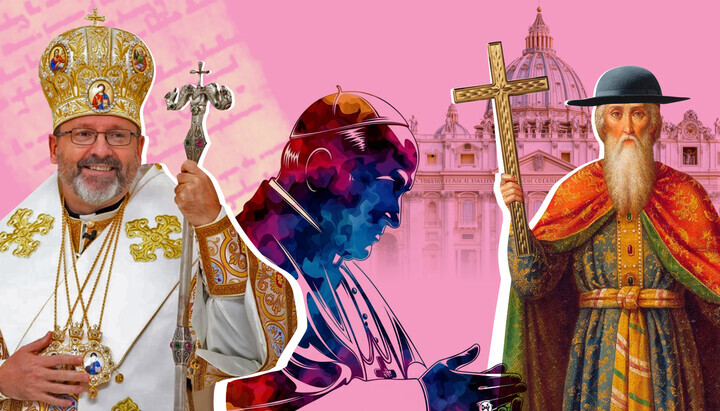
The head of the UGCC brought the relics of Prince Vladimir into a Uniate cathedral in Rome and declared that Vladimir was stolen from the Uniates by “Moscow invaders.”
On July 6, 2025, the head of the Ukrainian Catholics of the Eastern Rite, Sviatoslav Shevchuk, solemnly brought the relics of the holy equal-to-the-apostles Prince Vladimir into the Uniate Cathedral of Saint Sophia in Rome.
And here the question naturally arises: how did the relics of an Orthodox saint suddenly end up with the Uniate primate? The answer is unexpected — they were handed over to the “fullness of the UGCC” on January 23, 2025, by former Metropolitan Oleksandr Drabynko. While accepting the relics, Shevchuk once again stated the unity of Orthodoxy and Catholicism:
“Holding in our hands the relics of Saint Vladimir, we see that in his time all of Christianity was united, there was no division between Constantinople and Rome, between Catholics and Orthodox. Christ’s Church was one. He is for us a witness of that undivided, united Church,” said the head of the Uniates.
But the division did exist, and more on that below.
While transferring the relics to the Roman Uniate church, Shevchuk declared:
“Today, in the context of the work of the Synod of Bishops of our Church in Rome, we solemnly brought into this holy temple the relics of the equal-to-the-apostles Grand Prince Vladimir. The very Vladimir who was stolen from Ukraine by Moscow invaders is today returning to his Church.”
To “his Church”—where? To Rome? To the UGCC? And who are these “Moscow invaders”? In this context, Drabynko’s words from 2010 sound unusual—he said that he was the very author of the ideology of the “Russian World.”
But Shevchuk’s bold statements on that day did not end there. Mentioning that the UGCC cathedral in Rome was built by the “patriarch” (UGCC leaders do not have the right to be called patriarchs) Josyf Slipyj, Shevchuk said:
“And at that time he wished to be buried in Saint Sophia Cathedral in Kyiv. Our patriarch rests in Saint George’s Cathedral in Lviv. But the day will come when he will solemnly rest in our mother cathedral of golden-domed Kyiv.”
A very clear claim to the triumph of the Union in contemporary Ukraine.
Another statement by Shevchuk:
“Today Prince Vladimir himself says that the Church which was born in the waters of the Dnipro through that baptism he gave to our people is here. We are the heirs of this Kyivan Christianity.”
By the way, Shevchuk likes to pretend that deceased people speak through him. For example, on September 10, 2023, on the 400th anniversary of the “martyrdom” of Josaphat Kuntsevych, Shevchuk said something similar:
“Today Josaphat tells us: children of Ukraine, never listen to those who tell you to renounce that unity. For our Church survived through all historical epochs, endured those who wanted to eliminate it, thanks to being in unity with the great universal family of the Catholic Church…”
This is the very same Kuntsevych who seized Orthodox churches and drove Orthodox people into union so brutally that even the Polish chancellor Lew Sapieha, a Catholic by confession and a staunch supporter of the Union, wrote of him:
“Not only I, but others too strongly condemn that the priest-bishop of Polotsk began to act too harshly in matters of faith, has become very annoying and repulsive to people both in Polotsk and elsewhere.”
More about Kuntsevych can be found in the article "On the Stone, Unity, and Josaphat Kuntsevych." One can only imagine what will happen if the admirers and followers of Kuntsevych seize the “mother cathedral of golden-domed Kyiv.”
The Truth About the “Unity” of Orthodoxy and Catholicism in the Time of Saint Vladimir
Now to the fact that the division between Orthodoxy and Catholicism already existed in the time of Saint Prince Vladimir, and that he firmly rejected unity with the Vatican.
The main historical source that recounts that era is The Tale of Bygone Years by Saint Nestor the Chronicler, written in Kyiv in the 1110s. It contains an account of how Saint Vladimir chose his faith. To convert him, emissaries came to Kyiv from Muslim countries, Jewish Khazaria, and Catholic Rome. Here is how Nestor describes the visit of the Catholics:
“Then foreigners came from Rome and said: ‘We were sent by the Pope,’ and addressed Vladimir: ‘Thus says the Pope to you: Your land is like ours, but your faith is not like ours, for our faith is light; we worship God who created heaven and earth, the stars and the moon, and all that breathes, while your gods are just wood.’
Vladimir asked them: ‘What is your commandment?’
And they answered: ‘Fasting as one is able: if one drinks or eats, it is all to the glory of God, as our teacher Paul said.’
Then Vladimir said to the Germans: ‘Go back where you came from, for our fathers did not accept this.’”
Then emissaries from Constantinople came to Kyiv, and Rus’ accepted Orthodoxy. From The Tale of Bygone Years, it is clear that in the time of Prince Vladimir, Roman Catholicism and Orthodoxy were already distinctly different. Even though the formal schism, dated to 1054, had not yet occurred, everyone already clearly understood that Orthodoxy and Catholicism were not the same.
Why did Saint Vladimir say that “our fathers did not accept” Catholicism? Who were those fathers? And why did they reject Catholicism? This refers to events several years earlier during the reign of Saint Princess Olga, baptized as Helena.
A 10th-century Western chronicle, The Continuation of Regino, recounts that in 961, a man named Adalbert was sent to Rus’. But instead of baptizing Rus’ and subjecting it to the Pope, he was shamefully expelled from the lands of present-day Ukraine. In 962, the Continuation of Regino states:
“This year Adalbert returned, who had been appointed bishop for the Ruthenians, because he accomplished nothing of what he had been sent for, and saw all his efforts in vain. On the return journey, some of his companions were killed, and he himself barely escaped with his life.”
Saint Princess Olga rejected baptism from Rome, and this is what her grandson, Saint Prince Vladimir, told the Catholic envoys.
And a few more words on why Olga refused to have Rus’ baptized by Catholics and expelled Adalbert. One of the reasons was that from 904 to 963, the Vatican experienced one (but not the only) shameful chapter in its history, known as the “pornocracy.”
For 60 years, the Vatican was dominated by debauchery, incest, intrigue, murder, corruption, and drunkenness. This is how Pope John XII, who occupied the papal throne during the reign of Princess Olga, was described by his contemporary Liutprand of Cremona:
“He committed adultery with the widow of Rainer, with the maid of his father Stephen, with the widow Anna, and with his own niece, and turned the sacred palace into a brothel.
…he blinded his confessor Benedict, who later died, and killed John, a cardinal subdeacon, after castrating him…
All the clergy and laity said that he drank wine with the devil. They said that while gambling, he called upon Jupiter, Venus, and other pagan gods. They even said that he did not celebrate Matins and never made the sign of the cross.”
More on this can be found in the article “What Princess Olga Did for Rus.”
Even if only part of this is true (though other sources confirm it), one can only be horrified by what was happening on the Roman “Holy See” at the time. Could Saint Olga, and then Saint Vladimir, have subjected Rus’ to such a pope? Could they have been in unity with the Vatican, as Shevchuk tries to convince us?
Here is another confirmation that Rus’ never considered the Latin faith its own and was never in unity with Catholic Rome. In the 12th century, the great saint of our land, Saint Theodosius of the Caves, wrote to Kyiv Prince Iziaslav:
“I, Theodosius, humble servant of the Holy Trinity, Father, Son, and Holy Spirit—born in the pure and righteous faith and raised in good instruction by Orthodox father and mother. Do not partake of the Latin faith, do not follow their customs, avoid their communion and shun all their teachings and morals. Beware, children, of heretics and all their conversations, for even our land is now filled with them.”
As we can see, Saint Theodosius had the same attitude toward Catholicism as Saints Olga and Vladimir.
Testimony of T. Shevchenko
In the 16th–17th centuries, our ancestors did not heed the legacy of Saint Theodosius, allowed Catholicism into our country, signed the Union with Rome, and began to impose it by violence and deceit. This led to one of the most tragic periods in Ukrainian history, eloquently called the Ruin. The much-honored Taras Shevchenko vividly portrayed the consequences of the Union in his poem To the Poles. Every Ukrainian should know it by heart, to avoid repeating the same historical mistakes:
Back when we were still Cossacks,
And the Union was unheard of,
Then life was truly joyful!
We fraternized with free Poles,
Took pride in the open steppes,
In the gardens we loved, we blossomed,
Girls bloomed like lilies.
Mothers were proud of their sons,
Of their free sons… They grew,
The sons grew and gladdened
The old sorrowful years…
Until, in the name of Christ,
The priests came and set fire
To our quiet paradise. And they spilled
A vast sea of tears and blood,
And orphans — in Christ’s name —
They tortured and crucified.
Cossack heads bowed low,
Like trampled grass.
Ukraine weeps, moans — weeps!
One head after another
Falls to the ground. The executioner rages,
And the priest, with a rabid tongue,
Cries out: “Te Deum! Alleluia!”
Why the Canonization of Sheptytsky is Needed
This is exactly where Shevchuk is leading us today. And not only he, but also the Ukrainian authorities. Very synchronously, the head of the UGCC brought the relics of Saint Vladimir to Rome, and the president of Ukraine went to the Pope.
On July 9, 2025, President Zelensky met with Pope Leo XIV in the Vatican and, among other things, lobbied for the canonization of another Uniate figure—Andrey Sheptytsky.
“I told His Holiness about the respect Ukrainian society holds for the figure of Andrey Sheptytsky, his actions, including saving Jews during World War II and defending the Christian faith,” said Zelensky.
Did Zelensky also tell Pope Leo how Sheptytsky welcomed the “victorious German army” in 1941, how in 1942 he called on Ukrainians to go into forced labor in Germany—where hundreds of thousands died from hunger and brutal conditions—and how in 1944 he wrote a letter to Stalin thanking him for uniting Ukrainian lands with the USSR?
More on Sheptytsky can be found in the article “Why Are Ukrainians Being Lied to Again About Sheptytsky’s ‘Heroism’?”
Now let us consider why the Ukrainian authorities are so eager for Sheptytsky’s canonization. Could it be because they want to ensure the triumph of the Union in Ukraine—one of the main goals of Sheptytsky’s life? Here’s what Pope Pius XII said:
“Through you, Ukrainians, I want to unite the East, and the way to this union was shown by Sheptytsky.”
One can only imagine the scale of PR that will follow if Pope Leo agrees to canonize Sheptytsky.
What To Do So That the Ruin Doesn’t Repeat
What should we do to prevent another disaster in Ukraine, another Ruin, and another attempt to Catholicize our country? Above all, we must remain faithful to Orthodoxy, to our Church, not fall for sweet Jesuit rhetoric from the Uniates, and not believe fairy tales that Saint Prince Vladimir was in union with the Vatican.
Let us remember and fulfill the will of our venerable father Theodosius and not forget what Taras Shevchenko wrote.
